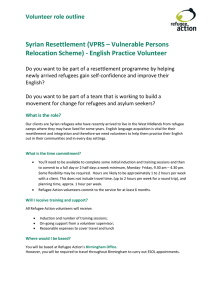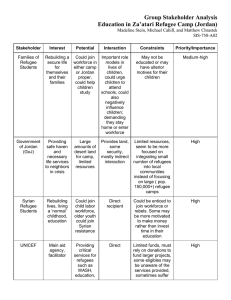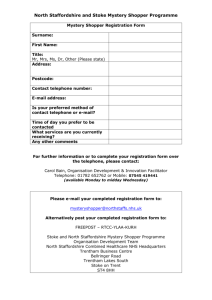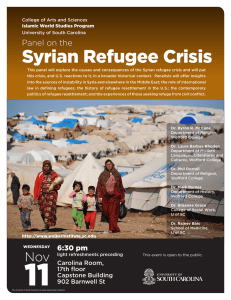EDS Outcomes Evidence Template - Stoke-on
advertisement
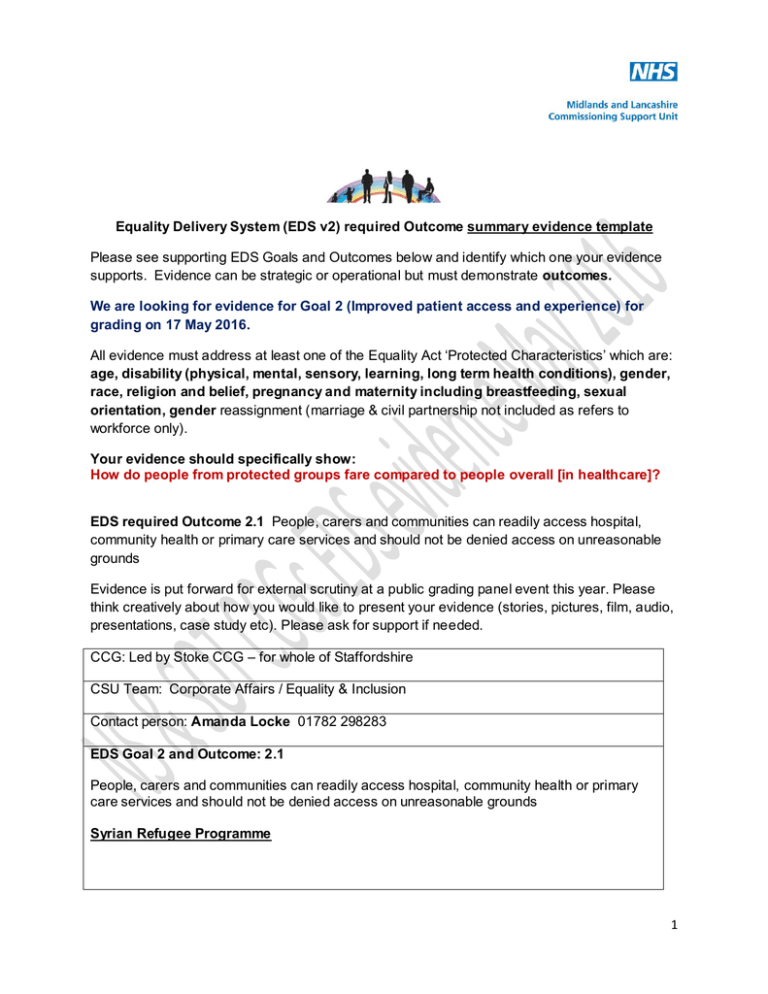
Equality Delivery System (EDS v2) required Outcome summary evidence template Please see supporting EDS Goals and Outcomes below and identify which one your evidence supports. Evidence can be strategic or operational but must demonstrate outcomes. We are looking for evidence for Goal 2 (Improved patient access and experience) for grading on 17 May 2016. All evidence must address at least one of the Equality Act ‘Protected Characteristics’ which are: age, disability (physical, mental, sensory, learning, long term health conditions), gender, race, religion and belief, pregnancy and maternity including breastfeeding, sexual orientation, gender reassignment (marriage & civil partnership not included as refers to workforce only). Your evidence should specifically show: How do people from protected groups fare compared to people overall [in healthcare]? EDS required Outcome 2.1 People, carers and communities can readily access hospital, community health or primary care services and should not be denied access on unreasonable grounds Evidence is put forward for external scrutiny at a public grading panel event this year. Please think creatively about how you would like to present your evidence (stories, pictures, film, audio, presentations, case study etc). Please ask for support if needed. CCG: Led by Stoke CCG – for whole of Staffordshire CSU Team: Corporate Affairs / Equality & Inclusion Contact person: Amanda Locke 01782 298283 EDS Goal 2 and Outcome: 2.1 People, carers and communities can readily access hospital, community health or primary care services and should not be denied access on unreasonable grounds Syrian Refugee Programme 1 Which of the following protected characteristics have been addressed? √Age √Gender Gender re-assignment √Disability √Race √Religion or Belief Sexual orientation Marriage and Civil Partnership Pregnancy maternity What is the evidence for each protected group indicated? Syrian refugee families with high level healthcare needs – being resettled across Staffordshire (led by Stoke). All ages; Muslim and Christian faiths; range of disabilities eg physical and mental health needs. Syrian refugee families with high level healthcare needs – being resettled across Staffordshire (led by Stoke). All ages; Muslim and Christian faiths; range of disabilities eg physical and mental health needs. Syrian refugee families with high level healthcare needs – being resettled across Staffordshire (led by Stoke). All ages; Muslim and Christian faiths; range of disabilities eg physical and mental health needs. Syrian refugee families with high level healthcare needs – being resettled across Staffordshire (led by Stoke). All ages; Muslim and Christian faiths; range of disabilities eg physical and mental health needs. Syrian refugee families with high level healthcare needs – being resettled across Staffordshire (led by Stoke). All ages; Muslim and Christian faiths; range of disabilities eg physical and mental health needs. What is your evidence focus / Area of good practice The Syrian Vulnerable Persons Resettlement Programme is managed nationally by the Home Office. In 2015 the UK Government made a pledge to resettle up to 20,000 Syrians in need of protection during the term of this Parliament. A Syrian Vulnerable Person (SVP) is defined as any person who has been classified as such by the Authority following referral by the UN High Commissioner for Refugees (UNHCR), and has arrived in the UK having been admitted to the Programme. Staffordshire County Council and Stoke on Trent City Council have approval to resettle a total of 70 Syrian refugees. The CCGs started working with the local authorities in November 2015 to develop a process to provide a rapid assessment of the individual healthcare needs of the identified cases put forward by the Home Office. The process that we have developed locally commences with the local authorities who notify 2 the Home Office once vacant properties have been identified. The Home Office will then provide ‘cases’ which are made up of up to 6 individuals, usually family members. Case files are then shared with the local authorities and the CCGs. These case files include a health assessment that each refugee has undergone in the camp where they are residing in Syria. A rapid GP assessment (within 5 days of notification) of the capability of the local health economy to meet the needs of the cases that have been identified is then undertaken. T he health assessment information provided by the home office is reviewed against the accommodation identified by the local authority and a recommendation is then made back to the Local Authority as to whether the health needs of the individuals can be met by the local health economy and whether the identified property is suitable for the individual given their physical health requirements. Case study example 1: Male who required a heart and lung transplant. His needs could not be met by the local infrastructure. His care would have had to have been delivered by the major care centres that would have required extensive travel for the individual and his family members in providing support for him during his care and rehabilitation. A recommendation was made that the family should be resettled in a health economy that had the infrastructure to meet his needs to reduce the need for travelling to receive care and enable his family to support his care and maintain close contact throughout any hospital stays. CCG recognised he would have needed long term care and English was not his first language and he would be reliant upon public transport networks to access care. Therefore, resettlement in the local health economy was not a suitable solution for him. Case Study example 2: Male who was diagnosed with a brain tumour that required urgent surgery. As UHNM is a recognised neurology centre the local health economy was able to accommodate him. Once CCG have provided the rapid assessment we then work as part of a multi-disciplinary team with Refugee Action (national charity) to identify a GP Practice for the SVPs. We do that by looking for the GP who is in closest proximity to the identified property. The CCG then communicates with the practice; setting up protocols to share the health assessment forms and ensuring the practice have access to interpreter services through Language-line. This ensures that the refugees are registered with a GP promptly after their arrival and enables them to access all mainstream healthcare services. The CCG also provides information on 1-1-1 services; how to access emergency care; and we provide information on 24 hour pharmacies. This means that if health issues occur prior to registration, the refugees can be supported. Good Outcomes for people from protected groups - what happened? Context: (Race / Age / Gender / Disability / Religion or Belief - eg some Muslims and some Christian refugees) Some SVPs may have been tortured and some may have experienced abuse. By making 3 GPs aware of the health assessments prior to registration it enables the consultation to be tailored and any specific needs of the individuals can be met. It also enables the GP to identify a range of health screening, that may be required. To date 4 families/groups of individuals have been resettled. The resettlement programme plans to meet their needs locally; getting them linked up with a local GP and integrated into local main stream healthcare services / all statutory support services eg housing etc. Evidence of ‘You said. We listened. We did.’ The processes we have put into place are in response to national directive. The Prime Minister made the pledge that nationally the UK would look to resettle 20,000 vulnerable Syrians over the life of the current parliament. Local Authorities and the CCGs then agreed to the numbers of refugees coming to Staffordshire. The County Council commissioned Refugee Action to support the resettlement programme. 4
